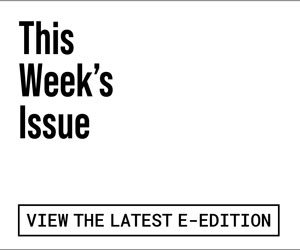 Bill Veltrop—social visionary, leading architect of organizational design and the revered local who believes the next big thing isn’t a ‘thing’
Bill Veltrop—social visionary, leading architect of organizational design and the revered local who believes the next big thing isn’t a ‘thing’
Every morning Bill Veltrop rises at 4 a.m. and enters into a meditation and conversation with the Universe. By mid-morning, he’s either working on a project or holding a workshop.
It’s 10 a.m. now, but before Veltrop proceeds with our interview he clangs together two golden meditation chimes and the three people in the room with him breathe in unison. Slowly the resonance fades to silence. The group is invited to recap their thoughts, hopes and stresses in a ritual Veltrop calls “stringing the beads.”
This is one of many exercises that Veltrop, considered to be a social visionary and a leading architect of “organizational design,” employs in the leadership-building change work that he has dedicated half of his life to. The work has garnered him much attention and the individuals participating in the retreats that he and his wife, Marilyn, host in their Soquel home seem eager to soak up the 82-year-old’s wisdom. But when he speaks it’s hard to imagine that the man is in his eighties. His enthusiasm and bright-eyed smile—even the wrinkles on his face are fine and hardly visible—suggest he’s many years younger.
“I see the next age to be an age of conscious evolution of our social systems,” Veltrop says, noting that he envisions our current volatile age as a necessary historical step on the way to a more sustainable human existence. And if you look back over the great ages of humanity—hunter/gatherer, agrarian, industrial, and the nascent information age—in each case, you can observe that “things” have been the primary focus of human societies.
He’s quick to also note that as a living species, humans have become excessively “thing” oriented. He believes our species’ continuity depends upon people moving beyond a primarily thing-centric culture.
 When asked to name problems in the world that he seeks to combat, he lists the economy and our sustainable relationship with the rest of nature.
When asked to name problems in the world that he seeks to combat, he lists the economy and our sustainable relationship with the rest of nature.
“I’m not good at a litany of all the things that are wrong,” he adds. “I think that’s so well covered by so many, and I don’t find it particularly useful to go there.”
What’s useful, perhaps, is to reflect upon a grand transformation that took place in Veltrop’s life, one that led him to relish the potential for others to also transform.
“What makes me so optimistic?” he asks. “For one, nature makes me optimistic. If I look anywhere in nature, I see incredible feats of design; elegance. Here are all of these inter-playing, ever-evolving, extraordinarily complex, beautiful life forms that are co-existing. Whatever it is that produced all of this is available to us.
“We’ve been given the capacity to make choices,” he goes on. “We’ve been given the capacity to be conscious of our consciousness. Our task is to open ourselves to listen, open ourselves to trust that the Universe is a friendly place.”
And how Veltrop arrived at that conclusion is fascinating to explore.
Exxon and Human Potential
During the first 40 years of Veltop’s life, he didn’t “string the beads.” Born and raised in the Midwest, he earned engineering degrees from the University of Missouri before spending 33 years with Exxon Oil Corporation (between the 1960s and 1980s)—called “Esso” at the time—and engaged in three separate careers.
 One of those careers was in project engineering, another in linear programming operations, where computers were used to plan systems to optimize refinery operations. The third was in the realm of organizational design and transformation.
One of those careers was in project engineering, another in linear programming operations, where computers were used to plan systems to optimize refinery operations. The third was in the realm of organizational design and transformation.
It was at his third and final Exxon career that Veltrop realized his ability to effect change, even at a hugely bureaucratic level at a large organization. This, he says, was among the first ingredients of his inner transformation. But before any true breakthrough, he had to endure a serious breakdown.
“A number of things happened at age 40,” he explains. “The first 40 years of my life were relatively unconscious.”
At that time, Veltrop’s stock market investments plummeted in a bullish market, his first marriage was failing, and his children were struggling in school as a result. On top of that, the major project Exxon had assigned to him had “grown into a cybernetic Vietnam.”
“All of these things hit at once, and I think it woke me up to looking at myself,” he says.
He became increasingly engaged in the Human Potential Movement (HPM), which rose out of the social and intellectual milieu of the 1960s. The movement was based on cultivating extraordinary potential believed to be largely untapped in all people. Advocates proposed that, through the development of human potential the quality of individual life could exceptionally improve to embrace creativity and fulfillment.
According to the HPM, the process was cyclic. Those who began to unleash this embedded potential would find their actions within society assisted others to release their potential, and more. This would, in turn, bring about a positive social change at large.
Another major event was meeting Herb Stokes and having the opportunity to see what was possible in terms of an organizational design. Stokes was a pioneer in generative organization design. His work in the 1970s with the Procter and Gamble Paper Products (P&G) plant in Albany, Ga., in which Veltrop participated, is widely recognized in the field of organizational design.
Organizational design is defined as the alignment of structure, process, rewards, metrics and talent with the strategy of a given business.
The large factory, located in the deep South, employed thousands of people—40 percent of the employees were African American, 20 percent were female. At the time, that employee demographic was unprecedented. In Stokes’ design, the highly diverse technician teams not only managed themselves and their complex paper-making operations, but also managed their own work assignments. These technician teams were self-led rather than answering to a long string of command, as is the way of many large factory organizations. The plant has been in operation for 30 years, and is still setting performance standards within P&G and the paper products industry.
Veltrop notes that Stokes is one of the best examples of generative organization designers he ever encountered, and considers him to be a valuable mentor in the early days of his organizational change career.
In 1985, Veltop left Exxon and soon underwent a metamorphosis. He assigned himself a two-year sabbatical, which he dedicated to a self-motivated research project. He set out on a one-person inquiry into who was successful in transforming large systems. “I mostly looked at corporations,” he says. “I interviewed some 130 different practitioners, change leaders, executives, theorists … and looked at 30 different large organizations who had gone through transformative work.”
This project served as a basis for the subsequent foundation of the International Center for Organizational Design (ICOD) in 1990. ICOD worked to pull together change champions form the corporations Veltrop had studied. ICOD staged events of rough by 150 participants over several days in Santa Cruz, Washington, Colorado, Oregon and Canada.
“The intent there was to take my first crack at reinventing the field of organization development, which has been a theme for the last 30 years at least.”
Afterward, Veltrop assigned himself two more years of sabbatical, which was dedicated almost entirely to inner therapeutic and spiritual development. “I was quite eclectic in the therapeutic realms, but was very much influenced by both Buddhism and the earth wisdom teachings,” he says. “I spent a lot of time on the Santa Cruz mountaintops with Rainbow Hawk and Wind Eagle.”
This combination of increased participation in the HPM, personal spiritual growth, and successful organizational redesign work as a private consultant for corporations, led Veltrop to become a leading architect of sustainable or generative change in the field of organization design and transformation.
By transformation, Veltrop means a fundamental, irreversible change in the culture of an organization.
“That usually means something shifts in their structures and systems as well,” he says. “Basically, the transformations were from organizations that tend to be silo-like and very hierarchical in terms of command and control, to organizations that were much more designed to support the people who are actually doing the interfacing of the production, or working with the customers.”
Veltrop now has more than 30 years’ experience in the U.S., Canada, Europe and the Far East, working closely with a number of Silicon Valley businesspeople, both as an internal and an external consultant.
Pathfinders, Regional Metamorphosis and … Marilyn
Veltrop and Marilyn celebrated their 16th wedding anniversary last October. “Our first attraction was the work we would do together,” he says. “We have our separate work but we also have work that we do together.”
He says meeting Marilyn was an extraordinarily important moment; that she was a “perfect complement” to the realms he had been specializing in and concentrating on. He also notes that his previous spiritual growth and transformation was essential so that when he met Marilyn he was not “found wanting.”
Before the couple met, though, Veltrop’s focus on systemic design had been strategic. Marilyn’s influence, bolstered by a doctorate in transpersonal psychology, added a new edge to the work Veltrop had been doing for years. Together, they founded the Pathfinder Circles in 2000, a retreat program designed to build leadership capacity in its attendees through a cooperative group search for inner identity.
 The Pathfinder circles have proven to be very powerful as a means of supporting leaders and, as Veltrop points out, “tapping into their full potential, and making a transition from a world view that is dominated by our existing systems, to one where we are creating conscious, living systems.
The Pathfinder circles have proven to be very powerful as a means of supporting leaders and, as Veltrop points out, “tapping into their full potential, and making a transition from a world view that is dominated by our existing systems, to one where we are creating conscious, living systems.
“We also have done quite a number of chrysalis retreats that either involve one leader or a couple who live with us for three days,” he adds. “We design the retreat to support their emergence, their metamorphosis, if you will. Marilyn and I are looking at working more and more of a team as we move into this next decade.”
With Marilyn’s influence, Veltrop’s focus gradually shifted from a focus on individual leadership-building and organizational design to a “bigger picture” ideal with an emphasis on groups and entire regions. This led to the foundation of the Monterey Institute for Social Architecture (MISA) in 2006.
MISA emerged by virtue of relationships that Veltrop and Marilyn developed in the Pathfinder Circles. It began as a group of four tight-knit individuals, lightheartedly self-titled “the men of MISA,” who came together to examine a field of social architecture—developing the capacity of leaders in our various societal systems to become evolutionary architects, or “social architects.”
“I see the information age as providing the platform to move into the next great age,” he says. “The next great age will be a transformation of social architecture. Our current social architecture has its roots in the industrial age or earlier. It hasn’t been reinvented.”
Is society beginning to see a reinvention of our social architecture by way of social media and the current anti-corporate movement? Veltrop certainly thinks so, pointing out the “Occupy” demonstrs as a first step toward transforming what’s possible in gatherings.
“Our social systems are wanting to change, but we need a strategy that goes beyond simply pointing to what’s wrong,” he says. “We need a strategy that supports the transformation of those systems. And that’s what we’re focusing on at the Monterey Institute of Social Architecture.”
For the first two years, MISA spent several days each month reflecting upon what they intended to do together. From those sessions came another offspring: “Regional Metamorphosis.”
“I’m optimistic about the potential of Regional Metamorphosis as being an important puzzle piece,” he says. “I know of countless people that would give almost anything to have an opportunity to both make a large contribution to the planet and to be fully developing and giving their gifts.”
A caterpillar’s immune system naturally resists metamorphosis. Its genetic code causes the production of more and more imaginal cells—similar to stem cells—the immune system is overwhelmed and transformation begins. Similarly, Veltrop points out, regions often resist change—even when the change is for the better. Regional Metamorphosis is a region-centric effort at enacting sustainable change in our social systems, by fostering individual skill sets.
“In transforming our systems, what we concentrate on is never the technology of the systems, but more the design of the chrysalis’s that need to be ongoing and need to support the kinds of transformation that have to be dealt with to transform a complex system,” he notes. “We intend to scope out how to get traction in terms of doing the early stages of a metamorphosis exploration for any given region.”
For Veltrop, Marilyn and MISA, the work of transforming systems concentrates on the people within those systems rather than the technology of the system. Of particular interest to Veltrop is looking into ways to develop a system that offers fulfilling work for all.
“We are the only species right now that has an unemployment problem, so there is a flaw within our social architecture,” says Veltrop. “Basically, to transform our various systems means we need to draw from cutting-edge thinking in the social realms, the environmental realms, in the technological realms … shift our beliefs from beliefs that are killing us to beliefs that will enliven us.”
Similarly, Regional Metamorphosis is only possible if people within a region’s social systems step up and begin to ratify change. There are certain people within every region who take the initiative in their particular field. These people are investors, multimedia storytellers, professors, web designers, doctors, school principals and so on. Veltrop calls these people “Game Ready Infinite Players,” or GRIPs.
“I’m finding more and more GRIPs,” he says. “I know of countless people that would give almost anything to have an opportunity to both make a large contribution to the planet and to be fully developing and giving their gifts. I would love to see people encourage existing leaders in existing systems who have the courage and vision to transform their systems, to come forward.”
Veltrop seeks to connect with people in the Monterey Bay region, and promises an interesting conversation to anyone interested in speaking with him about Regional Metamorphosis. He believes speaking about and envisioning a great change in a person, a system, or a region is the first step toward enacting one.
“I’m from Missouri, and Missouri is the ‘Show Me State,’ so for a long time, for me, it was, ‘seeing is believing,’” Veltrop muses. “But I’m becoming convinced that the opposite is more true—that what we believe tends to determine what we see. And I’m seeing more and more people stepping into their capacity to create a future that works for all. And so, it’s the non-thing that’s the next big thing.”
Learn more at GlobalGEA.net Photos: Keana Parker










